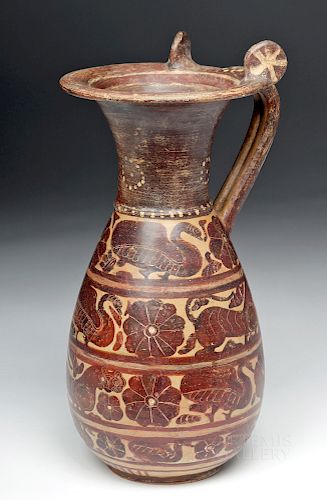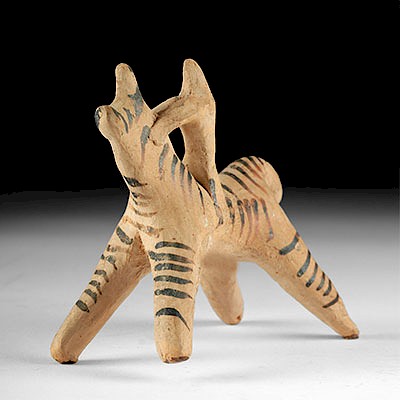Fine Greek Italo-Corinthian Olpe - Birds, Panthers
Lot 18a
About Seller
Artemis Fine Arts
686 S Taylor Ave, Ste 106
Louisville, CO 80027
United States
Selling antiquities, ancient and ethnographic art online since 1993, Artemis Gallery specializes in Classical Antiquities (Egyptian, Greek, Roman, Near Eastern), Asian, Pre-Columbian, African / Tribal / Oceanographic art. Our extensive inventory includes pottery, stone, metal, wood, glass and textil...Read more
Estimate:
$10,000 - $15,000
Absentee vs Live bid
Two ways to bid:
- Leave a max absentee bid and the platform will bid on your behalf up to your maximum bid during the live auction.
- Bid live during the auction and your bids will be submitted real-time to the auctioneer.
Bid Increments
| Price | Bid Increment |
|---|---|
| $0 | $25 |
| $300 | $50 |
| $1,000 | $100 |
| $2,000 | $250 |
| $5,000 | $500 |
| $10,000 | $1,000 |
| $20,000 | $2,500 |
| $50,000 | $5,000 |
| $100,000 | $10,000 |
| $200,000 | $20,000 |
About Auction
By Artemis Fine Arts
Oct 25, 2018
Set Reminder
2018-10-25 11:00:00
2018-10-25 11:00:00
America/New_York
Bidsquare
Bidsquare : Antiquities from Egypt, Greece, Italy, Asia
https://www.bidsquare.com/auctions/artemis-gallery/antiquities-from-egypt-greece-italy-asia-3538
Featuring Egyptian, Greek, Roman, Etruscan, Near Eastern, plus Asian art from Central and Far East. If you love the classics, this is the sale for you. Artemis Fine Arts info@artemisgallery.com
Featuring Egyptian, Greek, Roman, Etruscan, Near Eastern, plus Asian art from Central and Far East. If you love the classics, this is the sale for you. Artemis Fine Arts info@artemisgallery.com
- Lot Description
Greece, Corinth, Italo Corinthian (Etrusco-Corinthian), ca. 600 to 575 BCE. A stunning bichrome pottery wine pitcher (olpe) with a piriform body resolving to a narrower neck that gradually widens to a flared rim, and a bifurcated handle joining rim to shoulder. Two decorative circular discs - each one detailed with an abstract painted star burst motif - are applied to the rim, flanking the upper end of the handle. The body is decorated with four friezes presenting processions of birds and panthers interspersed with flowers - all delineated in red and umber slip against a creamy beige ground and incised with extensive details. Red and cream striations separate the friezes. Finally three dotted rosette motifs adorn the field at the lower end of the neck; another one adorns the rim, between the raised disks; additional red and cream bands decorate the interior of the rim, and three groups of vertical frets decorate the lowest section of striated bands just above the base. Truly a beautiful example! Size: 6.75" W x 12.125" H (17.1 cm x 30.8 cm)
The Corinthian style evolved from the earlier Geometric style. Surfaces were traditionally organized into horizontal bands, with an emphasis on repeated patterns, as well as an attractive play between light and dark. The Corinthian potters elected to expand the bands encircling the vessels, and fill them with both abstract, non-figural design motifs and zoomorphic images. On occasion they also included anthropomorphic motifs.
An Etrusco-Corinthian olpe sold at Christie's New York - sale 9796, Antiquities, December 5-6, 2001, Lot 534, for $14,100.
See a similar olpe by the Hercle Painter listed for $15,000 by Royal Athena and published in: J. Eisenberg, Art of the Ancient World, 1985, no. 200; J. Eisenberg, Art of the Ancient World, 2014, no. 131.
Accompanying this piece are scanned letters written in German from former owner Michael Schindler discussing the piece dated to 1979 which translate as follows, "The first paper says basically that he confirms the authenticity of the listed works and that he always will take them back if there are problems. The second paper says that the pieces number 1, 2 (this vase), and 3 were inspected in the Roman-Germanic museum (RGM) in Cologne and in the academic institute in Bonn. Both were inspected there and considered to be authentic.
Provenance: private New York, New York, USA collection; ex-private German collection, acquired in 1979 from Michael Schindler, Cologne, Germany
All items legal to buy/sell under U.S. Statute covering cultural patrimony Code 2600, CHAPTER 14, and are guaranteed to be as described or your money back.
A Certificate of Authenticity will accompany all winning bids.
We ship worldwide and handle all shipping in-house for your convenience.
#130855Repaired from about a dozen pieces with restoration and touched up paint over the break lines.Condition
- Shipping Info
-
All shipping is handled in-house for your convenience. Your invoice from Artemis Gallery will include shipping calculation instructions. If in doubt, please inquire BEFORE bidding for estimated shipping costs for individual items.
-
- Buyer's Premium



 EUR
EUR CAD
CAD AUD
AUD GBP
GBP MXN
MXN HKD
HKD CNY
CNY MYR
MYR SEK
SEK SGD
SGD CHF
CHF THB
THB


















